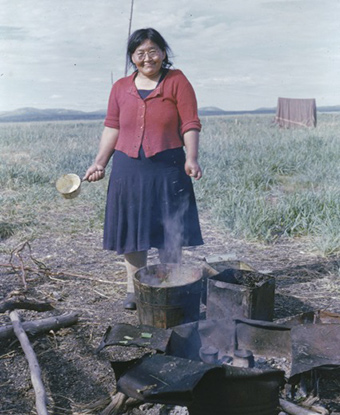Last updated: October 26, 2021
Person
Della Keats

Courtesy Elmer E. Rasmuson Library, University of Alaska Fairbanks
Della Keats was born in 1907 in Usualak, a settlement on the Noatak River, where her family participated in the Iñupiaq subsistence lifestyle. This involved moving between camps in different seasons to hunt and gather from the land. The seasonal camps that were home to Della and her people are the same lands now protected in Cape Krusenstern National Monument and Noatak National Preserve. She practiced subsistence throughout her life and would raise three children while working as a traditional healer.
Della was mostly self-taught in her healing, though she drew her methods from observations of other healers, stories, and her deep heritage’s traditions. Della utilized a combination of massage, cold and hot therapy, manipulation of the aorta and organs, and local medicinal plants like sarġiq (wormwood) for her healing.[1] One of the most important aspects of her work was the high level of intimacy between her and her patients. “If a person comes to you for help, make soft questions to him. That way he'll love you, and you'll love him…All my life I wanted to let them know. We need a calm day, a happy day all the time.”[2] Della treated all who needed it, both Alaska Natives and others groups, and worked as a midwife for 30 years in the greater Kotzebue area.[3] The medicinal use of plants gathered in the parklands and surrounding area is still commonly practiced today and is based on the knowledge of Iñupiaq elders like Della.
Della actively discouraged the mystification of her work and believed her methods did not need a shaman’s secrecy or overly technologic approach of modern doctors.[4] Della sought out trainees to continue her methods and pass on the history of Iñupiaq healing. “I love to teach the people. I don't want to keep something secret by myself. I want everybody to know. Try to show it, what I've done. I don't want to get just lost. I'm an old lady now, but from the beginning I always ask anything that I could learn. Momma used to tell me to teach people what I've done. I tell them not to forget what they learned from their grandparents.”[4] In addition to passing on the Iñupiaq knowledge of medicinal plants to those around her, she shared information with Anthropologists and Botanists like Ernest Burch and Anore Jones so that it could be shared broadly.
After a lifetime of healing and service to others and carrying on Iñupiaq traditions, Della passed away in 1986. Both during her life and posthumously, Della was bestowed with awards and honors. In 1983, she was awarded an Honorary Doctorate of Humane Letters in Health Sciences by University of Alaska Anchorage. The University also named two programs after her, the Della Keats Health Sciences Summer Program and the Della Keats Summer Research Program. In 2009, Della was inducted into the Alaska Women’s Hall of Fame and she has an entry in the National Library of Medicine. Maniilaq Health Center, headquartered in Kotzebue, celebrates Della Keats day each year in her memory. To this day the National Park Service, when hosting classes on native plants, recognizes Della Keats for her knowledge of the plants and the land for its healing power.
[1] https://arctichealth.org/media/pubs/76511/TRADITIONAL%20HEALING%20AMONG%20ALASKA%20NATIVES.PDF pg 31
[2] Alaskool http://www.alaskool.org/projects/women/profiles/acsw1983/D_Keats.htm
[3] https://www.nlm.nih.gov/nativevoices/timeline/424.html
[4] Alaskool http://www.alaskool.org/projects/women/profiles/acsw1983/D_Keats.htm
